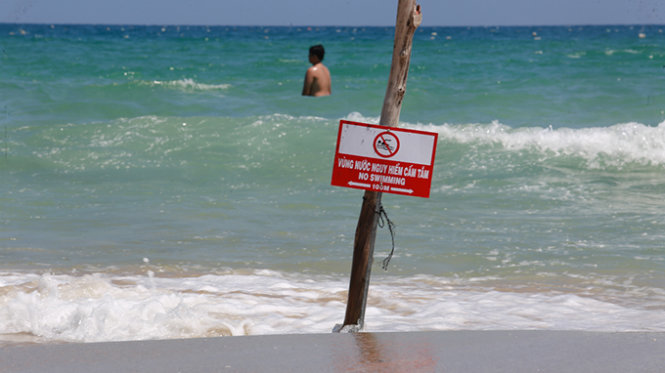Two gorgeous beaches in central Vietnam are plagued by perilous rip currents, which have killed eight, including a foreign tourist, since January.
Three drownings happened on Bai Dai and Bai Tay Beaches in Khanh Hoa Province’s Cam Ranh City between late January and February this year.
The accidents, which killed eight in total, including a Russian man, are scientifically believed to be caused by rips.
A rip is an area of rough water caused by waves meeting opposing currents.
According to local rescue teams, the dead victims were ignorant about the rips’ intense activity or heedless of danger warnings.

Rescue forces are shown searching for a missing victim in a drowning which happened in Cam Ranh waters on January 26, 2015. Photo: Tuoi Tre.
Bai Dai Beach, which spans from Cu Hin Pass to the northeastern area of Navy Zone 4, boasts a pristine, stunning beach with gentle slopes.
According to Dr. Le Dinh Mau, deputy head of the Oceanography Institute, the beach sees the most vibrant rip activity during the transition time between summer and winter each year.
Dr. Mau has been doing extensive research on the rips which are active along the Khanh Hoa coast.
Bai Dai and Bai Tay Beaches are home to the highest concentration of rips in Vietnam and most of them can be identified with naked eyes, he noted.
The rips toward Bai Dai’s southern area become less dense but more perilous, as their width is great and the currents’ velocity is high, at around 0.5 to 2.5 meters per second.
“Our research reveals that the rips at the gently sloping beaches such as Bai Dai and Bai Tay are far more dangerous than those along steep beaches like Nha Trang,” Dr. Mau stressed.
Nha Trang is the capital city of Khanh Hoa.
Rips thus put bathers, even excellent swimmers, in deadly peril.
Huynh Van Nhat Tien, vice director of the Cam Ranh Tourism Service Center, said rescue teams have saved an average of 10 people each year from the roaring, menacing rips since they were established in 2010.
Though the center has erected warning signs and flags in the perilous waters and its coast rescue team is invariably active at tourist-packed spots, rip-related accidents still spiral out of control, as more and more locals and tourists have been flocking to Bai Dai Beach in recent times, Tien added.
“Many refuse to heed our warning signs and some even think we’re trying to keep them away from such waters for some reason,” he said.
Dr. Mau urged that rescue teams on Bai Dai and Bai Tay be fortified and efforts be made to raise people’s awareness of rips and enhance their knowledge of warning flags and signs.

A grieving father is pictured sobbing at the sight of the body of his young daughter who drowned in Cam Ranh waters on January 26, 2015. Photo: Tuoi Tre
He also suggested a few simple ways to identify rips.
A telltale sign is that sand on the beach is shaped like an oyster shell, while the water nearby has currents which flow in reverse directions out into the sea.
A calm water area which is deep blue and usually between 150 and 200 meters wide and is sandwiched between crested waves can be indicative of a rip.
Rips can also be identified if floating objects or foam on the seemingly calm water are pulled offshore, Dr. Mau said.
Tien, of the Cam Ranh Tourism Service Center, observed that once stuck in rips, the victims will sink quickly and be washed away from where they are for some dozens to a hundred meters in no time at all.
The victims will be very likely to drown soon as they panic and desperately try to swim against the currents toward the shore.
Tien advised that swimmers in distress stay composed and let the rips wash them away from the shore.
They can swim horizontally as soon as the rips weaken and find ways to get back to the shore.
Meanwhile, bystanders are supposed to shout encouraging words to help the panicking victim regain composure.
Those who attempt to help should not dash into the water where the struggling victim is, but should swim sideways instead, bring along life vests and buoys, and try to rescue the victim from a safe distance with ropes or other means.
Like us on Facebook or follow us on Twitter to get the latest news about Vietnam!





















































